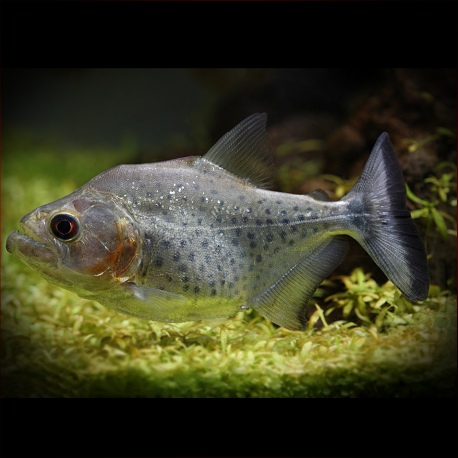More info
Datasheet
| Minimum Tank Size | 255 litres / 67.36 US gallons |
| Maximum Size | 17.3cm / 6.81inches |
| Temperature | 24°C / 75.20°F - 28°C / 82.40°F |
| Hardness | 2-15ºdH |
| pH | 4.5-7.0 |
General Description
Serrasalmus Altuvei, commonly known as Altuvei or the Blue Caribe, is a member of the Serrasalmidae family. It is a scarce species in the aquarium trade, closely resembling other species within the compressed group of Serrasalmus. The distinguishing features between S. altuvei and similar species were described in 2001 by Fink and Machado-Allison, emphasizing morphometric differences and pigmentation patterns. The genus Serrasalmus has historically been challenging to differentiate, leading to the need for a detailed revision. Serrasalmus species are distinct from true piranhas, with clear morphological differences, and are not considered aggressive unless threatened.
Aquarium Setup
Serrasalmus Altuvei thrives in a planted aquarium with ample shaded areas and natural decor like roots, branches, and floating vegetation. It is recommended to avoid bare setups, as these fish prefer more natural surroundings. Water quality must be maintained at a high standard, with a moderate flow rate to simulate its natural habitat. External canister filters or sumps are ideal, and protective measures for aquarium equipment, such as heaters, are necessary due to the species' behavior. Regular partial water changes are essential to keep the tank clean.
Behaviour
Altuvei should only be kept as a specimen fish due to its aggressive nature towards tankmates. It is not recommended to house them with other species or conspecifics as they may exhibit territorial behavior and fight until only one remains. These fish are not gregarious by nature and are best kept alone to prevent conflicts in the aquarium environment.
Feeding and Diet
In the wild, S. Altuvei feeds predominantly on the fins of other species and smaller fish. In captivity, they can be weaned onto dead foods but may require some acclimation. Juveniles enjoy live or frozen bloodworms, Tubifex, Artemia, and chopped prawns, while adults should be fed larger items like mussels, cockles, and chopped squid. It is essential to avoid feeding them large amounts of mammalian/avian meat and "feeder" fish to prevent health issues.
Reproduction & Dimorphism
There have been no reports of S. Altuvei reproducing in captivity, and sexual dimorphism is unknown at this time. Further research is needed to understand their reproductive behavior and any distinct physical differences between males and females.
Habitat and Distribution
Native to the tropical grasslands of the Llanos in Venezuela, S. Altuvei is primarily found in the Venezuelan section of the Rio Orinoco basin. They inhabit waters with clear, sunlit conditions and lush aquatic plant growth, preferring to live singly rather than in groups across their limited range.

